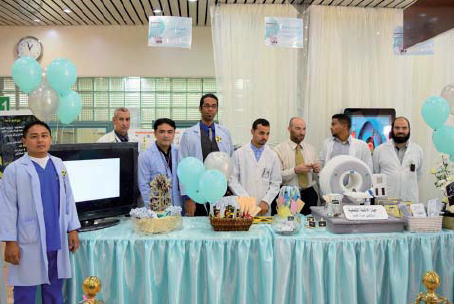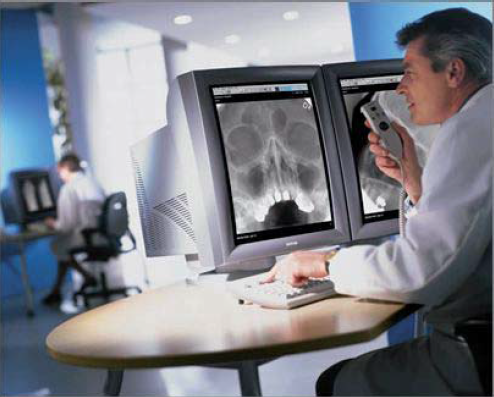
In addition to special lectures and courses being held to mark the
International Day of Radiology, hospitals and radiology departments all across the world held open days and special events to make the public more aware of radiology.

In addition to special lectures and courses being held to mark the
International Day of Radiology, hospitals and radiology departments all across the world held open days and special events to make the public more aware of radiology.
Re-posted from Diagnostic Imaging (DI) Europe with permission.
Timed to coincide with the date (8th November) of the discovery of X-rays by Wilhelm Röntgen in 1895, the International day of radiology (IDoR) has now evolved into an annual event of “action and awareness” organized by the main radiological professional societies, such as RSNA, ACR and the ECR, as well as an umbrella radiology organizations on all continents. Thus, throughout the world all sorts of events were organized with the stated objective of “building greater awareness of the value that radiology contributes to safe patient care, and improving understanding of the vital role radiologists play in the healthcare continuum”.
There is no doubting the validity of such a laudable intention, but now in the fourth annual celebration of IDoR (the first was launched amid much pomp in 2012) the real question remains whether the IDoR is actually achieving its objective. Even more practically, just exactly how do you measure whether actions to “alert the world to the stunning medical, scientific and even artistic possibilities of medical imaging, the essential role of the radiologist as a part of the healthcare team in countless medical scenarios, and the high educational and professional standards required of all staff working in medical imaging” are actually succeeding?
It goes without saying (but is nevertheless worth while repeating) that radiology with all its various imaging modalities has become more than ever a central unavoidable facility in modern medicine. This makes it all the more depressing that, time after time, surveys of the general public show that they have indeed very little idea of exactly who a radiologist is (most patients confuse the radiographer with the radiologist) and even less on what the radiologist actually does.
Such misunderstanding on the part of the public is bad enough, but what is perhaps even worse is that the morale of many radiologists themselves is continuing to sag under the pressures of ever-increasing work-loads. Therein lies the paradox of the profession. The more the role of radiology becomes central in medicine, the more the workload increases and the more the radiologist is in danger of being perceived as an out-of-sight anonymous provider of images and reports.
The biggest impact on the typical radiologist’s workload has come from the dramatic increase in the number of cross-sectional imaging studies (i.e. CT or MRI) being carried out. By definition the three-dimensional nature of these modalities means that radiologists are spending more and more time in reading the images. A recent study highlights just how dramatic is the impact of such an increase in workload (McDonald RJ, Schwartz KM, Eckel LJ, Diehn FE, Hunt CH, Bartholmai BJ, Erickson BJ, Kallmes DF The Effects of Changes in Utilization and Technological Advancements of Cross-Sectional Imaging on Radiologist Workload. Acad Radiol. 2015 Sep;22(9):1191-8).
A group of researchers from the Mayo Clinic analyzed the statistics at their institution on the use of cross-sectional imaging over the last decade and found that the combined numbers of CT and MRI carried out over this period doubled but that, over the same period, the number of individual images being interpreted increased more than ten-fold. This translated into the average radiologist at the Mayo Clinic who was reading CT or MRI examinations being required to interpret one image every 3-4 seconds in an 8-hour workday to meet workload demands!

The modern radiologist is facing ever-increasing workloads and is often perceived as an out-of-sight anonymous provider of images and reports.
However there may just be a glimmer of light at the end of the workload tunnel. In one particular sub-field, namely that of pediatric CT— and let’s not forget that the particular focus of this year’s IDoR is indeed pediatric radiology — there may be just a suggestion that the otherwise inexorable growth trend in the number of radiology examinations is being bucked. A recent study in one group of US pediatric hospitals (Parker MW, Shah SS, Hall M, Fieldston ES, Coley BD, Morse RB Computed Tomography and Shifts to Alternate Imaging Modalities in Hospitalized Children. Pediatrics. 2015 Aug 24. pii: peds.2015-0995) showed that, although there still was a steady increase in the total number of imaging studies carried out on children, for several pediatric diagnostic-related groups the number of CT examinations was actually declining.
One explanation for this is that, finally, the incessant banging of the drum through many campaigns such as “Image Gently” about the dangers of ionizing radiation in children is finally bearing fruit. It is still too soon to see whether there is any similar trend in the number of adult CTs. However this mini-trend should not be interpreted as a sea-change in overall radiology trends. On the contrary, it should be remembered that in the study by Parker et al., overall, the number of imaging examinations still rose. Even if pediatric CT was declining, this wasn’t due to fewer overall exams being carried out; instead CT was being replaced by alternative imaging modalities.
In the light of all this it is not surprising that the morale of the profession can suffer. Of course technological innovations and developments provided by the industrial suppliers of equipment and software to the profession can help by providing ever more efficient and powerful systems, but there are limits to workflow improvements in the face of such growing workload requirements.
So maybe the focus of the International Day of Radiology should in future be directed less to convincing the general public of the importance of radiology and more to reminding radiologists themselves of the importance of their profession, a victim of its own success.
Alan Barclay, Ph.D., is the editor of Diagnostic Imaging (DI) Europe.
The post IDoR: Paediatric Imaging a Bright Spot in Advancing Radiology appeared first on Everything Rad.








